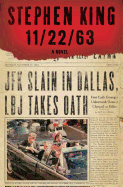
| Publisher: | Scribner | |
| Genre: | Suspense, Fiction, Alternative History | |
| ISBN: | 9781451627282 | |
| Pub Date: | November 2011 | |
| Price: | $35 |
| Fiction |
by Stephen King
Jake Epping is a high school English teacher in Maine who accepts a summons over the phone from Al Templeton, the owner of the local diner. He isn't sure what to expect, but it definitely wasn't a wormhole in the back room that leads to the 1958 version of their town. Al's dying request is that Jake use the time tunnel to stop Lee Harvey Oswald from assassinating John F. Kennedy.
Shortly before he learns about the gateway to the past, Jake reads an essay by one of his students about the night in 1958 when his father came home drunk and killed the rest of his family, so preventing that murder becomes his immediate concern. As he bides his time in the 1960s, taking a job as a high school teacher in a small town outside of Dallas, he could be just another stranger who shows up, makes a difference in people's lives and falls in love with a beautiful but emotionally damaged young librarian--except, of course, for the very thing that makes him an outsider in the first place.
King spends a lot of time presenting the late 1950s and early 1960s through the eyes of a 21st-century man-- what songs are playing on the radio, what movies are at the drive-in, and how much cheaper everything is. But he also shows us how much more blatant, and uglier, the racism and sexism were in that era. At first it seems as if King isn't particularly concerned about the complications of time travel; when Jake brings up one of the classic paradoxes--"but what if you went back and killed your own grandfather?"--Al's response is bluntly dismissive: "Why the f*** would you do that?" Later on, though, when Jake is telling his girlfriend about his mission, he starts to describe the butterfly effect, and she mentions she's already heard about it, thanks to Ray Bradbury's "A Sound of Thunder"--a big clue as to how things are going to turn out.
Kennedy surviving Dallas is a staple of alternate history hypotheses, so much so that it's basically become an abstraction. 11/22/63 revitalizes the concept and gives it a renewed emotional power. --Ron Hogan

| Publisher: | Houghton Mifflin Harcourt | |
| Genre: | General, Fiction, Historical, Literary | |
| ISBN: | 9780547577531 | |
| Pub Date: | November 2011 | |
| Price: | $27 |
| Fiction |
by Umberto Eco, trans. by Richard Dixon
We enter into the world of Umberto Eco's new novel via a "Narrator" who brings the Reader into a darkened room where an elderly man hunches over a desk writing. The Narrator doesn't know who he is or what he's writing. We'll find out together. It turns out to be a diary, dated March 24, 1897, and Eco begins to tell us a story via the diary, with some sections summarized by the Narrator, "so as not to unduly bore the Reader."
The diarist is a Jew hater, Simone Simonini, and he's telling us how he created the infamous Protocols of the Elders of Zion, the phony plan for world domination supposedly written by a group of learned rabbis in the Prague Cemetery. Simonini is fictional, but the Protocols are real, first published in Russia in 1903 and invoked by anti-Semites from Henry Ford to Adolf Hitler. Thus Eco plunges us headfirst into the tumultuous and conspiratorial world of late 19th-century Europe, mixing real history with his fiction. (Black-and-white illustrations throughout The Prague Cemetery further mimic the look and feel of a genuine 19th-century novel.) The results are often intriguing, erudite tales that make heavy demands on the Reader and offer varying rewards. Overall, however, Eco succeeds in taking us on a dark, unsettling voyage into an insane mind filled with the worst kind of evil. --Thomas Lavoie, former publisher
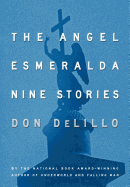
| Publisher: | Scribner | |
| Genre: | Fiction, Short Stories (single author), Literary | |
| ISBN: | 9781451655841 | |
| Pub Date: | November 2011 | |
| Price: | $24 |
| Starred | Fiction |
by Don DeLillo
There's probably no writer whose work is more emblematic of these unsettled and unsettling times than Don DeLillo, and in this collection of nine edgy stories, his first, he turns a wary eye on aspects of our contemporary predicament.
DeLillo's stories are long on atmosphere and short on tidy plot resolutions, often featuring characters alienated from themselves or their environment. In "Baader-Meinhof," a woman and man meet at an exhibit of paintings of the notorious 1970s German terrorist gang. They linger together for an afternoon, their encounter culminating in a scene of real menace in the woman's apartment. The protagonist of "The Starveling" passes his days in New York City movie theaters, and when he spots an anorectic woman engaged in similar activity, he stalks her across the city.
Readers of DeLillo's masterpiece Underworld may recognize "The Angel Esmeralda," portions of which appeared in different form in the novel. In it, Sister Edgar, an elderly nun, helps minister to a desolate section of the Bronx. There she encounters graffiti writers who "spray-painted a memorial angel every time a child died in the neighborhood." When 12-year-old Esmeralda Lopez is raped and murdered, her image becomes visible beneath a billboard advertisement--a tragic palimpsest--attracting hundreds of reverent observers each day to the site.
But the story that best reveals DeLillo's ability to capture the zeitgeist is "Hammer and Sickle," set among a group of white-collar criminals ("men in Maoist self-correction, perfecting our social being through repetition") who inhabit a minimum security prison camp. Each day they gather before the common room's television to watch the adolescent daughters of the story's narrator host a financial news show, their delivery as unnerving as it is chipper ("Even the numbers are panicking."). It's a story that evokes the atmosphere of our economic malaise with more chilling immediacy than a week of the Wall Street Journal.
The aftershocks of an earthquake in Greece, a Central Park kidnapping, the rumor of a Caribbean plane crash, high-tech warfare--they're the random, life-altering events that disturb our waking hours and haunt our dreams. And they're the stuff of Don DeLillo's short fiction, offered in all its stark, enigmatic singularity in this collection. --Harvey Freedenberg
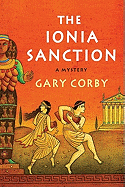
| Publisher: | Minotaur | |
| Genre: | General, Fiction, Mystery & Detective, Historical | |
| ISBN: | 9780312599010 | |
| Pub Date: | November 2011 | |
| Price: | $25.99 |
| Mystery & Thriller |
by Gary Corby
Nicolaos, the only private investigator in ancient Athens, has a problem. The Ephesian ambassador is dead, and Nicolaos let the murderer get away. Pericles, the ruler of Athens--who first hired Nico in The Pericles Commission--has threatened to fire him unless he can fix the problem. The sole clue to the killer's whereabouts lies with his former slave, Asia, so Nicolaos buys her, whereupon she reveals to him that she is only a slave because she was kidnapped; furthermore, she is the daughter of Themistocles, who was the hero of Athens until he defected to the enemy and became a powerful diplomat within the Persian Empire.
Pericles sends Nicolaos to Ephesus, a Greek enclave in the Persian Empire, to hunt for the killer and do a little spying on Themistocles. Nico is more than eager to go since the luscious Diotima, the woman he loves, is currently serving as priestess at the temple of Artemis there. Although angry that Nico is traveling with Asia, she agrees to help him, and the three head for the home of Themistocles, where they find a hotbed of conspiracy, sex, gluttony and torture.
The characters are quarrelsome, clever and sometimes downright funny as they keep backstabbing one another, forming new alliances, and speaking in double entendres. Amidst all this, Nico must decide where his loyalties lie while there's still time to stop the Persians from invading Athens. Full of real historical figures and fascinating insights into Greek and Persian culture, The Ionia Sanction is a delightful romp. --Jessica Howard, blogger at Quirky Bookworm
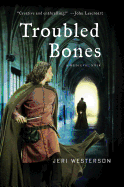
| Publisher: | Minotaur | |
| Genre: | Fiction, Mystery & Detective, Historical | |
| ISBN: | 9780312621636 | |
| Pub Date: | October 2011 | |
| Price: | $25.99 |
| Mystery & Thriller |
by Jeri Westerson
Troubled Bones is the fourth offering in Jeri Westerson's Medieval Noir series featuring degraded knight Crispin Guest. Years ago, Crispin was snared in a false treason plot contrived by his lord, the Duke of Lancaster, to out the religious heterodox; Crispin made the mistake of staying loyal to the Duke and was subsequently stripped of his title and holdings, forced to make his living as a Tracker, a finder of things and people. Joining him in this work is his adolescent apprentice, Jack Tucker, whom Crispin saved from Newgate Prison (back in The Demon's Parchment).
A Pardoner, a Miller, a Prioress, a Summoner, a Manciple and a Wife of Bath make a pilgrimage to Canterbury: sound familiar? Westerson has taken Chaucer's characters--and the poet himself, cast as an old friend of Crispin's--and seamlessly woven her own mystery around them. The Prioress and Sir Philip Bonefey are feuding over 10 disputed acres, formerly Bonefey's but recently ceded to the Prioress' House by an ecclesiastical court headed by Archbishop Courtenay of Canterbury. There's a murder, then a second, and soon readers are pulled into a tangle of heretical movements, court intrigue, crooked master stonemasons and the missing bones of the blessed martyr Thomas à Becket (if they're really missing, that is). Aficionados of medieval murder mysteries will delight in Westerson's accurate period details and an intriguing plot guaranteed to keep the reader guessing into the night. --Judith Hawkins-Tillirson, proprietress, Wyrdhoard Books, and blogger at Still Working for Books
An intriguing mystery involving a disgraced knight, Chaucer, assorted pilgrims and missing bones.
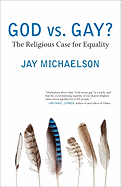
| Publisher: | Beacon Press | |
| Genre: | Sexuality & Gender Studies, Gay Studies, Social Science, Religion, Lesbian Studies | |
| ISBN: | 9780807001592 | |
| Pub Date: | October 2011 | |
| Price: | $25.95 |
| Nonfiction |
by Jay Michaelson
In spite of the legalization of gay marriage in several states, the increasing representation of gays and lesbians in popular culture and the repeal of the U.S. military's "Don't Ask Don't Tell" policy, the fight for LGBT rights in America is far from over. The arguments against equality are often religious in nature, but in God vs. Gay?, author and activist Jay Michaelson draws on significant research and his own experience as a person of faith and a gay man to show that it is possible to be both gay and religious--and that faith communities are enriched and strengthened by the affirmation of LGBT people.
Michaelson argues that while "there are a half a dozen verses that may say something about some forms of same-sex behavior, what they have to say is ambiguous, limited, and widely misunderstood," and more importantly, "there are hundreds of other verses that teach us about the importance of love, justice, and sacred relationships." Michaelson is far more concerned with that fundamental message of love and inclusion than in taking apart the problematic verses, though he does address them.
Michaelson applies impressive scholarship to his arguments, but God vs Gay? is not academic. Instead, it aims to reach religious people who may be struggling with inclusion, as well as homosexuals in spiritual crisis, and he writes with respect and sensitivity for all sides. He acknowledges that sexual diversity remains an issue that threatens deeply held beliefs of many people. "But, as with slavery and women's rights before it," he writes, "it is also a debate that invokes the best in us: our capacity for empathy, moral reasoning, and for love." --Hannah Calkins, blogger at Unpunished Vice
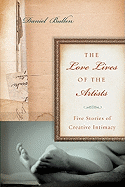
| Publisher: | Counterpoint | |
| Genre: | Biography & Autobiography, Literary | |
| ISBN: | 9781582437750 | |
| Pub Date: | October 2011 | |
| Price: | $28 |
| Nonfiction |
by Daniel Bullen
The creative personality tends to be restless, always craving and searching for new experiences to enrich the soul and thus deepen one's art. In The Love Lives of the Artists, Daniel Bullen examines the intersection of art and amorous love in the affairs of five artistic couples who had "open relationships" at a time when the sanctity of marriage, as an institution, adhered to more conventional expectations.
Artistic and erotic freedom is at the core of this complex, philosophically insightful book. Bullen has chosen partners who were both creative artists: Henry Miller and Anaïs Nin, Jean-Paul Sartre and Simone de Beauvoir, Lou Andreas-Salomé and Rainer Marie Rilke, Diego Rivera and Frida Kahlo, and Alfred Stieglitz and Georgia O'Keeffe. Their narratives chronicle often contradictory commitments, fidelities and infidelities as partners in each couple took and/or tolerated lovers (not always of the opposite sex) and justified their actions as necessary requirements to inspire and augment creativity and intellect. Bullen also examines the artists' personal histories, focusing on circumstances that may have led to such liaisons.
These pairings shattered the limitations of traditional romantic partnerships. They also influenced individual artistic development and often led to personal fulfillment. There was a price to be paid, however, and carefully chosen letters and journal excerpts document how Bullen's subjects were forced to grapple with issues of fear, rage, jealousy, cruelty, self-loathing, loneliness and, in some instances, destruction. In the end, their experiences of liberation and despair ultimately forged emotional turmoil into self-awareness and great art. --Kathleen Gerard, blogger at Reading Between the Lines
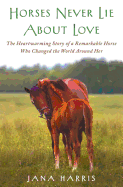
| Publisher: | Free Press | |
| Genre: | Animals, Biography & Autobiography, Wildlife, Horses, Personal Memoirs, Nature | |
| ISBN: | 9781451605846 | |
| Pub Date: | November 2011 | |
| Price: | $24 |
| Nonfiction |
by Jana Harris
Even if the closest you've been to a horse is watching Seabiscuit, don't let the title of Jana Harris's memoir deter you--it could just as easily have been titled True Colors, in honor of her masterful use of imagery, as well as the horse that helped her achieve her dreams.
In 1986, poet Jana Harris and her husband were offered teaching jobs in Seattle and decided to pursue her desire to breed and raise horses. They found a farm in the foothills of the Cascade Mountains and bought a deep red mare-in-foal named True Colors. When the mare finally arrives, months later, she is scarred from a range fire and terrified of everything--men, sudden movements, even the smell of fabric softener--but still pregnant, and eventually becomes the foundation of Harris's breeding establishment.
Through perseverance and determination, Harris is able to gain the mare's trust, and she describes the subsequent 25 years with True Colors using luminous imagery and characterization in the spirit of James Herriot's All Creatures Great and Small. Her gift for description finds the perfect subject matter in horses: "Her irises were a many-layered deep chestnut and when I looked into them I saw rock formations that reminded me of the Grand Tetons. Her body might have been here in our barn, but her soul was loose running across the scablands of the high desert range." Horses Never Lie About Love is a compelling tale of dedication, courage and faith. --Kristen Galles from Book Club Classics
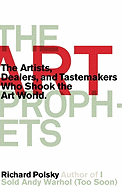
| Publisher: | Other Press | |
| Genre: | Art, General, Biography & Autobiography, History, Artists, Architects, Photographers, Contemporary (1945- ), Popular Culture, Individual Artists | |
| ISBN: | 9781590514061 | |
| Pub Date: | October 2011 | |
| Price: | $24.95 |
| Nonfiction |
by Richard Polsky
The Art Prophets is a fascinating book about 11 modern American art dealers who took chances on new artists and proved very successful in promoting and selling them, from the 1960s to the present day. As Prosky (I Sold Andy Warhol Too Soon) writes: "Each of these seers snatched something out of the wind and conjured up a hurricane that redirected the art scene." It's as much a book about business, markets, taste, culture and gambling as it is about art, which makes it all the more interesting.
Readers who aren't especially knowledgeable about modern art might enter into one of Prosky's chapters thinking a guy who collects posters, for example, wouldn't be that interesting, but it is--engrossing even, thanks to a lively style and Prosky's clear enthusiasm for the dealers he sees as courageous. Perhaps the oddest and riskiest venture of them all is Virginia Dwan's support for Earthworks, huge works of art, rooted in natural landscapes, that may not last and only a few people are ever likely to see--like Robert Smithson's immense Spiral Jetty, a rock formation set off the shore of the Great Salt Lake. (It's too bad Prosky couldn't include illustrations of the art works he discusses.)
Prosky's last chapter predicts art prophets will next be promoting the incredible western artists of Santa Fe and Taos; thus the new frontier for the art yet to be discovered and marketed is, in fact, the Frontier. --Tom Lavoie, former publisher

| Publisher: | University of Chicago Press | |
| Genre: | Travel, Literary Criticism, English, Irish, Scottish, Welsh, Great Britain - General, History, Europe | |
| ISBN: | 9780226301310 | |
| Pub Date: | November 2011 | |
| Price: | $22.50 |
| Nonfiction |
by Simon Goldhill
Literary tourism has been a lucrative business since the Victorians--especially in the United Kingdom. But why do readers come in droves to authors' birthplaces and homes? What magical experience do we expect when visiting the places they walked (and sometimes--though not always--wrote)? Simon Goldhill (Love, Sex, and Tragedy: How the Ancient World Shapes Our Lives) tackles these questions by traveling to five famous authors' houses-turned-museums, exploring--and satirizing--the myth of literary pilgrimage with equal parts scholarship and skepticism.
Goldhill's journey takes him down the length of Britain--from Sir Walter Scott's Edinburgh mansion, built by the author to promote his public image, to Freud's office in London, an unsettlingly meticulous re-creation of its counterpart in Vienna. Along the way, he visits Wordsworth's Dove Cottage, the Brontë parsonage and Shakespeare's Stratford-upon-Avon, musing on the idea of place as inspiration, the contrast between a writer's private life and constructed public persona, and the connection between literary and spiritual pilgrimages--the shared impulse to follow in the literal footsteps of one's heroes. Though unmoved by the sterile, velvet-roped atmosphere of the Brontë home, and annoyed by gift shops stuffed with overpriced tchotchkes, Goldhill does have a few epiphanies by journey's end--including the realization that he's actually enjoying his pilgrimage.
Part travel memoir, part literary inquiry, with a large dose of history and frequent dashes of dry humor, this book will appeal to bookworms, Anglophiles and anyone who loves to visit historical sites but rolls their eyes at the overpriced rubbish in the gift shop. --Katie Noah Gibson, blogger at Cakes, Tea and Dreams
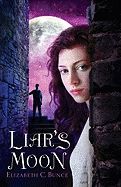
| Publisher: | Arthur A. Levine | |
| Genre: | Love & Romance, Fantasy & Magic, Mysteries, Espionage, & Detective Stories, Juvenile Fiction | |
| ISBN: | 9780545136082 | |
| Pub Date: | November 2011 | |
| Price: | $17.99 |
| Children's & Young Adult |
by Elizabeth C. Bunce
In the opening pages, Digger, otherwise known as Celyn Contrare, is thrown into jail. There she learns that a friend who helped her escape from Werne the Bloodletter's guards (in book one) has been arrested for murder. Even in the face of mounting evidence, she has no doubt of her friend's innocence. But she doesn't have much time to clear his name. Even if he doesn't end up facing the gallows, the powerful family of the murder victim has their own plans for revenge--plans that include an ever-growing body count.
Elizabeth Bunce made a name for herself with her award-winning debut novel, A Curse as Dark as Gold, a reworking of the Rumplestiltskin fairy tale. For the Thief Errant series, she creates her own magical world. Blending an almost Victorian sensibility with magic and fantasy, Bunce delivers nonstop action and still manages to shape surprisingly complex characters. The story builds to a heart-stopping conclusion and ends with a cliffhanger revelation that is sure to leave fans anxious for the next installment. --Sherrie Petersen, children's book reviewer and blogger
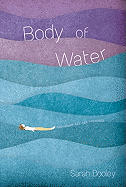
| Publisher: | Feiwel & Friends | |
| Genre: | General, Self-Esteem & Self-Reliance, Social Issues, Family, Juvenile Fiction, Bullying, Homelessness & Poverty | |
| ISBN: | 9780312612542 | |
| Pub Date: | October 2011 | |
| Price: | $17.99 |
| Children's & Young Adult |
by Sarah Dooley
Twelve-year-old narrator Ember, her mother, father and seven-year-old sister, Ivy, are religious, but in a way that makes many people uncomfortable. They do "spells," and call upon nature instead of God, in a practice that her mother calls "Not Quite Wicca." When the family's trailer burns down--a suspected act of arson--they lose their home, their source of income and Ember's beloved dog, Widdershins.
Anson and Ember have been best friends since they met five years ago, but something wrenching has happened to tear them apart. As this emotionally nuanced tale unfolds, it becomes clear that Ember blames Anson for her great losses. With stringy hair and 15 extra pounds, Ember feels unattractive already, and her family's beliefs set her further apart. The family moves to a campground where she eschews any new friendships. Ember visits the trailer park on Wednesdays to collect relics that survived the fire, such as half a pair of scissors and Widdershins's collar. The one place Ember finds solace is while floating in the lake. She believes that "if I could just float for a while--just put my ears under where I couldn't hear the pop-sizzle-crack of burning wood," she could make it through another day. Her rage simmers while her family's hope falters and stalls.
The strain bursts during a storm that destroys life as they know it once again, but what it leaves in its wake is immeasurable. Ember realizes that putting forth positive energy, in any form, is the most powerful and healing force of all. --Bette Wendell-Branco, bookseller emeritus and reviewer